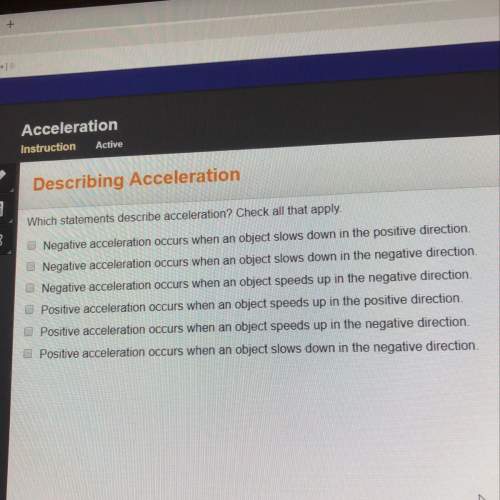
Physics, 06.03.2020 19:02 KArrington815
Nerve signals in the body occur when a small voltage, called an action potential, is applied across the membrane of a cell. When this action potential is applied across a region of the cell membrane called an ion channel, current in the form of moving potassium ions will be established across the cell. If, during an action potential of 85 mV, a single ion channel with a resistance of 1.4 GΩ, is opened for 0.9 ms, approximately how many singly-ionized potassium ions travel through the channel during this time?

Answers: 3


Another question on Physics

Physics, 21.06.2019 23:00
Asubmarine has a "crush depth" (that is, the depth at which water pressure will crush the submarine) of 250 m. what is the approximate pressure (water plus atmospheric) at this depth? (recall that the density of seawater is 1025 kg/m3, g = 9.81 m/s2, and 1 kg/(ms2) = 1 pa = 9.8692 10-6 atm.) a. 34.8 atm b. 24.8 atm c. 25.8 atm d. 7.8 atm
Answers: 2

Physics, 22.06.2019 15:40
Question 1 what is amperage? is the rate of doing work. is the rate of flow of protons in electric current. represents the amount of pressure behind electron flow. is the rate of flow of electrons in electric current. 2 points question 2 what is voltage? is the rate of doing power. represents the amount of pressure behind electron flow. is the rate of doing work. is the rate of flow of electrons in electric current. 2 points question 3 what is power? is the rate of flow of protons in electric current. is the rate of flow of electrons in electric current. is the rate of doing work. represents the amount of pressure behind electron flow. 2 points question 4 if we multiply volts times amps we get what? power circuit work current 2 points question 5 what are two ways alternating currents are similiar? in both ac and dc electrons flow in the same pattern. in both ac and dc, the flow of electrons changes directions back and forth. both ac and dc are only possible in certain materials with atoms that will allow electron flow. both ac and dc involve the flow of electrons. 4 points question 6 how does the flow of electrons flow in an alternating current? the flow of electrons is always slower in an alternating current than within a direct current. the flow of electrons is not constant and forward; it changes direction back and forth. electrons flow from from a higher affinity to that of a lower affinity. electron flow is constant and only in a forward direction. 2 points question 7 what is the flow like in a direct current? the flow of electrons is not constant and forward; it changes direction back and forth. the flow of electrons is constant and only in a forward direction. the flow of electrons go from a higher affinity to a lower affinity. the flow of electrons are always faster in a direct current. 2 points question 8 how is an electric current able to flow? electrons flow from the higher affinity to lower affinity and electrical current is generated. protons flow from the higher affinity to lower affinity and electrical current is generated. the movement of protons from one atom to another leads to an electric charge. the movement of electrons from one atom to another atom in a line results in a flow of electric current. 2 points question 9 how do electrons move from the two different types of metal in a battery? protons flow from the metal with the lower affinity to the metal with higher affinity and electrical current is generated. electrons flow from the metal with the lower affinity to the metal with higher affinity and electrical current is generated. electrons flow from the metal with the higher affinity to the metal with lower affinity and electrical current is generated. protons flow from the metal with the higher affinity to the metal with lower affinity and electrical current is generated.
Answers: 2


Physics, 22.06.2019 19:30
Which of the following compounds would be primarily ionic? methane, ch4, ammonia nh3, calcium chloride, cacl2, or carbon dioxide, co2
Answers: 1
You know the right answer?
Nerve signals in the body occur when a small voltage, called an action potential, is applied across...
Questions




Mathematics, 12.03.2021 01:30

Mathematics, 12.03.2021 01:30

Mathematics, 12.03.2021 01:30


Mathematics, 12.03.2021 01:30


History, 12.03.2021 01:30



Mathematics, 12.03.2021 01:30

Mathematics, 12.03.2021 01:30

History, 12.03.2021 01:40


Biology, 12.03.2021 01:40

Arts, 12.03.2021 01:40


Health, 12.03.2021 01:40




